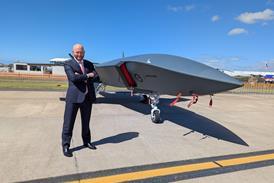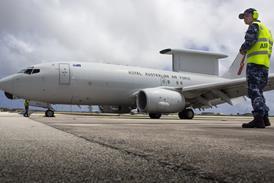The US Army’s Future Combat System Class III unmanned air vehicle competition appears to have been reduced to a race between the Piasecki Air Guardian and the AAI Shadow 300 systems.
Well-placed sources indicate that FCS prime contractors Boeing and SAIC have dropped Teledyne Brown from further consideration. In parallel Teledyne Brown has advised some of its teaming partners for the project that its bid, based on a modified Rheinmetall Defence Electronics KZO UAV, has been set aside.
Teledyne Brown bid director John Latimer declines to comment on the status of the bid, saying that he “can’t address that issue” until after a source selection announcement by Boeing-SAIC.
Boeing’s FCS programme office says the source selection process for the FCS Class III UAV is still under way and declines to comment on the status of the Teledyne Brown bid.
A decision is expected by the end of September based on the current schedule advised to contenders by the Boeing-SAIC programme office.
The FCS Class III system is intended to provide a medium tactical UAV capability, which will effectively replace the US Army’s existing AAI RQ-7 Shadow 200 systems from around 2014.
AAI, Piasecki and Teledyne Browne were shortlisted for the FCS Class III requirement in July 2005. All three firms received funded 10-month risk-reduction studies with responses lodged with the Boeing-SAIC FCS programme office in May. An announcement had been expected during July, but both the FCS Class III and Class IV UAV requirements have been undergoing requirements review in the wake of US Army concerns about how best to field large numbers of UAV in operational environments.
The US Army announced on 14 August that the FCS programme had successfully completed its in-process preliminary design review, with this defining requirements and functionality for 18 planned system types. The announcement reiterated existing plans for four classes of UAVs.
The Class III system selected by Boeing-SAIC will then undergo follow-on competitive evaluation against a DARPA-sponsored candidate, the Dragonfly Pictures DP-5X.
Teledyne Ryan bid two versions of KZO. The basic reconnaissance and surveillance variant, designated Prospector, was based directly on the German army KZO system, but adapted to meet US Army needs. Changes would have included introduction of catapult launch and a heavy fuel engine. Air vehicle endurance would have remained at around 6h, the same as the basic KXO. The second version, designated Thunder, was an adaptation of RDE’s developmental TARES loitering munition version of KZO.
The Piasecki Air Guardian is based on the Barnett BRC 540 autogyro airframe. A demonstrator made its first fully autonomous flight in 12 July this year. Piasecki is teamed with Lockheed Martin System Integration Owego, GeorgiaTech, and Geneva Aerospace.
Piasecki was last year selected as the preferred Boeing-SAIC candidate for the FCS Class II requirement and is now being evaluated alongside DARPA candidate systems for a final source selection in 2008.
AAI is still to detail its “Shadow 300” bid, based on an evolved version of the US Army’s existing Shadow 200 tactical UAV system.
Source: FlightGlobal.com























